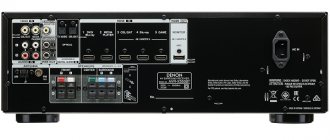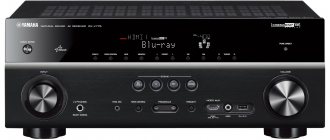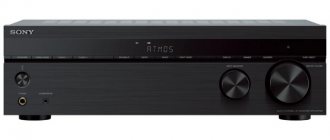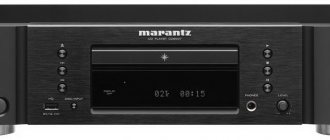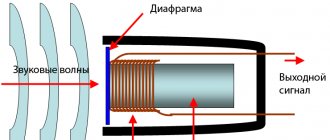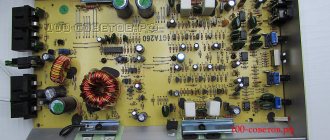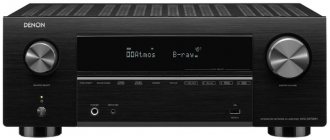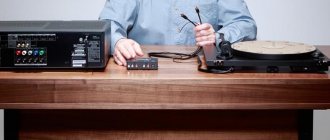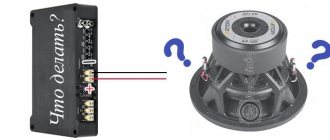AV receivers have long become a kind of reference device, containing almost everything for high-quality playback of audio and video content in a home system. Not a single cinema installation can do without a receiver - here it undeniably dominates, simultaneously playing stereo for the music lover.
At this stage of development, these devices have become truly universal and multitasking. To meet the ever-increasing demands from consumers, the functionality of modern receivers is undergoing many changes, which are sometimes not at all easy to understand. In this article I will try to highlight the most significant points, based on which the reader will be able to navigate the whole variety of receivers.
Sound comes first
Undoubtedly, one of the most important criteria when choosing an AV receiver is its compliance with modern configurations for connecting cinema acoustics. As a rule, modern devices have an initial configuration of 5.1.
With these parameters, the receiver will sound five speakers and one subwoofer. They continue the line of system configurations 5.2, 7.1, 7.2, 9.1, 9.2, 11.1 and 11.2. The 13.2 format is also available, but for now this is the province of top receivers; a couple or three will support 7.1 or 7.2 - such systems allow you to achieve a fairly high level of video dubbing.
Thus, the choice of receiver should first of all be based on the composition of the system that the cinema already has or is considering purchasing. Also, do not forget about the impedance of the acoustics - it will not be superfluous to make sure that it is compatible with the receiver you have chosen.
If you plan, in addition to watching movies, to organize a stereo pair using a receiver, pay attention to the support of high-quality audio formats by the selected device: FLAC and DSD. Typically, support for such formats means that the receiver has a dedicated DAC installed on board, which will have a beneficial effect not only on listening to music, but also on dubbing films. For gourmets, there are even models on the market with a built-in phono stage.
A few words about power: naturally, the more powerful the receiver, the more expensive it is. But if the size of the room in which the cinema/music lover area is supposed to be arranged does not exceed 20 square meters, a receiver with ordinary power indicators will be quite sufficient - this is 80–110 W.
But correlation with acoustic systems is also important. Here you need to remember that the power that the manufacturer indicates in the characteristics of the receiver is, as a rule, the peak load on one channel, and all channels will not be able to reproduce such power at the same time. But this is not a reason for concern, since when dubbing video, there are practically no scenes where peak power will be needed simultaneously in all channels of the receiver.
Close to the same topic is another parameter that many attach great importance to - this is the amplification class that is used in the receiver. Most of them work either in the respected class AB or in class D. It is worth considering that work in class AB is accompanied by significantly greater heat generation than in the case of class D.
Therefore, there should be enough space around such a receiver for its comfortable and timely cooling. Receivers with Class D amplification are less demanding when it comes to cooling, but you still shouldn’t put them in a wardrobe.
This point also includes the function of automatic sound correction in accordance with the room in which the cinema system will be equipped. This option is present in almost all modern receivers. Today there are several variations of it (Audyssey, YPAO, DCAC and others). Audyssey is considered one of the most successful among them. This function will greatly facilitate the process of setting up and matching the acoustics with the room.
Special attention should be paid to support for the multiroom system. This option allows the receiver to sound multiple zones (rooms). There can be two, three or more such zones, depending on the capabilities of the receiver. At the same time, it is possible to broadcast sound to each zone from both one and different sources simultaneously. Multiroom can be either wired or wireless. And if everything is clear with the wired implementation, then we’ll talk about the wireless one in the next section.
Select an AV receiver: evaluation criteria and device capabilities
As the title implies, this post is dedicated to a completely trivial thing - choosing an AV receiver. In such publications, there are often quite “denim” hints about the advantages of manufacturers or technologies used to create equipment. Contrary to such rules, I will try to describe the criteria that are significant for users as neutrally as possible and talk about what is important to consider when making such a choice. I will describe my personal preferences regarding receiver manufacturers and models in other articles.
I want to emphasize that I am writing this post for those who are sure that they need an AV receiver. For those who know that no alternative options in the form of active acoustics or a classic pair of speakers + traditional UMZCH are suitable. One can debate for a long time about the advantages of one or another choice, but there are situations in which a receiver is a conscious necessity. The post describes several convenient methods for non-hardware subjective sound assessment, principles for calculating the required power, as well as the functionality of devices of this type.
5,7,9 or 11?
One of the basic questions that consumers ask when choosing receivers concerns the number of amplification channels.
Often the number of channels determines the cost. Many experts are convinced that using the good old 5.1 scheme is enough to create a realistic surround sound panorama. However, with the advent of Blue-ray discs with new standards for film soundtrack recordings, the situation has changed somewhat in recent years. Modern formats allow recording a seven-channel soundtrack, which in turn defines the trend. Moreover, the use of advanced surround sound technologies often involves the use of additional ceiling sources, which in turn require additional channels. For these reasons, seven-channel systems are the most common today. Five-channel receivers are still produced, which, as a rule, are present in the initial lines (price category up to 40,000 rubles), and there are also particularly successful models (or their upgrades), which are in high demand despite the small number of channels.
Models with 9 and 11 channel amplification are also widely available on the market, which make it possible to expand the panorama through the use of upper front and additional side sources. The use of such systems without sources with 9 or 11 channel sound recording causes a lot of controversy, since additional channels only duplicate those already existing in a 5.1 or 7.1 scheme. But it should be noted that such schemes are useful and justified when using technologies such as Dolby Atmos and DST-X.
In recent years, receivers with stereo subwoofers (5.2, 7.2, etc. systems) have become popular on the market. It is believed that stereo in the low frequency region can enhance the effects of surround sound.
My personal experience shows that creating a realistic scene is possible using a standard 7.1 circuit without additional front and side speakers, naturally, using an appropriate source and good speaker capabilities. However, with the widespread use of formats with a large number of channels, such systems will become more relevant.
Power and volume
One of the key acoustic parameters of an AV receiver is power.
As in the case of classic UMZCHs, when assessing this criterion, one should take into account the area of the room that should be sounded by the device and, accordingly, the power of the speaker system. In such systems it is important to have a power reserve, i.e. make sure that the power of the receiver is greater than the power of the speaker. Firstly, this will minimize the distortion that appears and not use volume limits. Secondly, if you need to purchase speakers of higher power, for a larger area, the reserve will come in handy. It should be noted that the volume of the system as a whole (i.e., the level of sound pressure created) will depend not only on the power of the amplifier and speakers, but also on the sensitivity of the acoustics. Thus, the same receiver at the same volume level can sound different with different speakers.
With a room size of 30 sq. m. Most experts recommend an amplification power of at least 50 W (accordingly, the average power per 1 sq. m. should be about 1.5 W). As I wrote above, these values are quite arbitrary and largely depend on the sensitivity of the speakers. The presented data is relevant for speakers with a sensitivity of 85-90 dB. Manufacturers often indicate exactly what volume (area) of the room their amplification capabilities are designed for.
Among other things, it is necessary to take into account the different approaches of manufacturers to assessing the power of an AV receiver. A number of Chinese and Asia Minor manufacturers still indicate PMPO in their specifications, i.e. peak power, which is not any informative indicator. Some crafts of these “proud” power are 1000 or 2000 W (PMPO), which may impress an inexperienced buyer, but would be very far from the truth.
A number of other manufacturers are more sophisticated: they indicate an honest RMS, but measure nonlinear distortion at low volume levels. At high volumes, these distortions increase significantly, and the speaker system begins to “choke” with sound. Therefore, to assess the real power and sound pressure, it is necessary to conduct a preliminary listening to the equipment or buy those devices that are already familiar to you.
Distortion and sound quality
Before purchasing a receiver, you should pay attention to the level of nonlinear distortion.
Harmonic distortion (THD) is indicated in the documentation for the device, as well as in the description of the characteristics on the seller’s website (if these are not indicated, you should think about the competence of the store and the quality of the device). Intermodulation distortion (IMD) appears much less often in the documentation, and accordingly, when choosing a specific model, it makes sense to look for these characteristics in tests published on the Internet and check them subjectively by ear (which will be discussed below). For the vast majority of modern receivers, the level of harmonic distortion is vanishingly small and does not exceed 1% for the entire frequency range at all volume levels. This is due to the fact that most of them are based on identical amplifier chips to clearly defined standards. It should also be taken into account that as the volume increases, the SOI also increases. Most experts consider the limiting value for intermodulation distortion in modern equipment to be 3% (measured using the standard 2-frequency method).
When purchasing a home device, it is unlikely that you will be able to use a test bench for testing. Carrying an oscilloscope to the showroom is not very convenient and quite troublesome. However, there are methods that allow you to subjectively assess sound quality and the appearance of nonlinear distortions with a relatively high degree of reliability. A comparative assessment of receivers by ear can be carried out similarly to similar tests for acoustic systems. The only difference is that one speaker and several different receivers are used.
“Use a disk with a 315 Hz sine wave signal (0 dB level), the volume is turned to minimum. After the “sine” starts, the volume gradually increases until the sound begins to distort (buzz, etc.). The volume level at which distortion began is recorded, then the second, third system, etc. is tested. The highest indicator indicates higher quality and fidelity of reproduction.”
The ideal way to subjectively compare the quality of AV receivers is to conduct blind testing
with previously known and unfamiliar musical material.
Intermodulation distortion can be subjectively determined by listening to a children's or women's treble choir. Blurred and unclear sound will indicate a high level of IMD. In subjective tests, one should also take into account the fact that the speaker introduces significantly more distortion than the receiver. In addition, ideally, use exactly the acoustics that you plan to use with this receiver (thus, it is easy to understand how the speakers fit a particular receiver).
Functionality
Integration and interfaces
It is believed that a modern AV receiver should have extensive functionality and that it is they that qualitatively distinguish it from traditional amplification devices.
For modern receivers, a high level of integration with mobile devices, as well as with PCs via wireless data transfer protocols (Bluetooth, AirPlay, Wi-Fi, etc.) and Ethernet, remote control via mobile applications, multi-channel transmission of video and audio information is almost mandatory , which makes them similar to multiroom systems. In addition, many modern receivers are equipped with coaxial and optical audio outputs, allowing you to quickly transmit audio signals in digital form.
Receivers without support for streaming services are gradually becoming a thing of the past, which by definition involves the use of an Ethernet or wireless connection to communicate with the network. Given the streaming integration, it makes sense to find out whether the receiver can support streaming without loss of quality. There are often cases of integration into the receiver of a player that reads data from an external storage device. If you need to connect a large number of devices, you should pay attention to the number of HDMI connectors. It is natural that the more there are, the higher the cost of the device.
Acoustic correction
One of the interesting features among modern models in the average (from 70 to 100 thousand rubles) price range are systems that can adapt the sound to the characteristics of the room. You can configure it automatically, using a special microphone, or manually, entering data about the speaker system, the location of the speakers and setting the necessary equalization and volume level for each speaker. It should be noted that not all AV receivers have such capabilities; moreover, there are cases in which room problems can only be solved using traditional acoustic treatment of walls, floors and ceilings.
Video functionality
Many AV receiver users note the usefulness of the image adaptation and deinterlacing functions. The essence of these functions is the processing of a television, PC or DVD signal by a special graphics processor, which results in scaling and artificial increase in resolution to Full HD or 4K. Experts from the USA especially quote video processors from manufacturers such as Marvell Qdeo or Anchor Bay, which, according to them, carry out image adaptation better than those built into TVs and playback devices.
Surround Sound
To realize the possibility of surround sound, there are a number of modes and standards that, to a certain extent, repeat each other. The most famous brands in this area are Dolby, DTS, Audyssey and THX. Using and selecting these modes can be a little confusing for the less experienced user, but there is some merit in experimentation and choice.
The most common formats that the vast majority of modern AV receivers support are Dolby Digital (Dolby Digital Plus) and DTS. For full playback of Blu-ray discs, Dolby TrueHD, Dolby Atmos, DST-X, DTS-HD Master Audio are used. Both from personal impressions and from expert reviews, the most advanced surround sound technologies today are Dolby Atmos and DST-X, which allow you to get the most realistic sound “canvas” with an extremely detailed, deep and accurate scene. At the same time, for the full operation of these technologies, ceiling acoustics are required, and, accordingly, the use of a 7.1 receiver.
Another functionality implemented in many AV receivers are decoders that allow you to convert a stereo signal into 5.1 or 7.1 surround sound. These include Dolby Pro Logic IIx, the more advanced Dolby Pro Logic IIz, Audyssey DSX, and DTS Neo: 6. I rate the effect of using such modes as impressive and interesting. But as a person who often prefers traditional stereo, I quickly get tired of such listening (especially for music).
Volume normalization and compression
I have never used the compression function as needed - only as an experiment, but for many people it is really necessary. Useful for those who watch TV channels with aggressive advertising, which often have a higher overall volume level. This function will also be useful for those whose neighbors have auditory hyperesthesia and react very painfully to increased volume behind the wall. A digital compressor cuts off amplitude and frequency peaks, which allows you to watch movies at night quite comfortably and without harming your neighbors.
Bottom line
The criteria for choosing an AV receiver are clearly determined by three factors:
- the need for certain functionality;
- sound and image quality;
- user budget.
With the increase in the number of interfaces, decoders, operating modes, integration capabilities and other user functionality, the cost of the device naturally increases. The majority of customers in our store (70% of those who answered this question) believe that a good AV receiver with sufficient functionality and capabilities can be purchased in the price range from 40 to 90 thousand rubles. For me personally, the most interesting options were receivers using Dolby Atmos and DST:X technologies, equipped with the ability to control via mobile applications. It is these features that I consider the most important, after the basic criteria for sound quality.
Connections with and without wire
Undoubtedly, one of the most common switching options in this segment is HDMI. This interface can be found on almost all modern multimedia devices. Therefore, of course, it is important how many incoming HDMI ports the receiver has.
The number of ports should be correlated with the number of devices that will be connected to the receiver using this protocol - be it a game console, Blu-ray player or TV. As a rule, modern AV receiver models have 4–6 or more HDMI inputs.
USB connectors will also come in handy. For the use of external storage media, the best connection method has not yet been invented.
When considering wireless interfaces, it is worth considering which of them will be relevant for a particular buyer. Because nowadays in the arsenal of receivers you can find almost all existing protocols and interfaces for wireless data transfer: Bluetooth, AirPlay, DLNA, Wi-Fi (often even dual-band - 2.4 and 5 GHz), as well as all kinds of streaming services for music lovers (Spotify , Tidal, Deezer, etc.).
Separately, it is worth highlighting the wireless implementation of the multiroom system, since to ensure its operation it is necessary to support special multiroom platforms both by the receiver itself and by the wireless speakers participating in the multiroom. Some of the most popular platforms are Sonos, MusicCast, HEOS, DTS Play-Fi, AirPlay 2 and Chromecast.
All this was created in order to facilitate the user’s process of creating and managing multiroom zones: most of the platforms have in their arsenal both an application for a smartphone and control using various voice assistants.
By the way, about voice assistants. In certain scenarios, this option greatly simplifies the management of the AV receiver's functionality. The device can either support working with all voice assistants at once (Amazon Alexa, Google Assistant, Apple Siri), or work only with one of them.
Using voice commands, you can turn the AV receiver on or off, adjust the volume, fully control music playback, mute/unmute the sound, change the selected input on the AV receiver, link or unlink rooms in a multi-room system setup, and control music playback in different rooms.
In general terms, this option carries additional useful functionality that takes receiver control to a whole new level.
The same useful additional functionality includes a smartphone application, with which the user has access to most of the receiver’s functions. Before purchasing a device, it is worth checking whether this control method is available - of course, if this option is relevant to the buyer.
How to choose a receiver for acoustics?
When going to the store to buy
a receiver for acoustics
, take with you your favorite audio recordings on CD or DVD discs. They must be of high quality. It is recommended to go to a salon where there is a huge selection of receivers for listening to music (for example, to the Moscow salon of elite acoustics Hi-Fi Design). There you can check the power and sound quality. Consult a sales consultant. Based on the prevailing opinion and expert advice, choosing a receiver for a specific acoustic configuration will be easier.
Working with video
Every year, 4K resolution is increasingly mastering gigabytes of content on the Internet. Now you can watch streaming video in this resolution even on popular video hosting sites. If the TV that will be paired with an AV receiver has a 4K resolution, it is logical to choose a receiver that supports the same resolution. The same applies to HDR - not all receivers are able to work with HDR TVs without reducing this functionality of the latter.
Some AV receivers have additional means for processing the video stream. The result is a kind of picture upgrade, which in some cases makes it more comfortable to perceive visual information of mediocre quality on high-resolution TVs.
Since we are talking about TVs, it is immediately worth mentioning the so-called Smart TVs. Such a TV very often itself acts as a source of content, and all that is required from the receiver is high-quality voice acting of what is happening on the screen.
For such situations, some receivers have an HDMI ARC (Audio Return Channel) or eARC connector. It allows you to use one HDMI cable for both the signal entering the receiver and the signal outgoing from the receiver, thus eliminating the setup from unnecessary wires. Of course, such switching is possible if the TV also has an HDMI ARC connector on its panel.
Some of the models of modern AV receivers are also capable of video multiroom. Simply put, they can provide video content to two monitors simultaneously.
What's better?
The choice must be made taking into account the scope of use of the device. This receiver is ideal for a home theater. It is designed for watching movies and provides multi-channel sound. This device helps you completely immerse yourself in the atmosphere of the cinema.
If you plan to assemble an audiophile speaker system, you will need a high-quality stereo amplifier. It is important to understand that it will be quite expensive. You won’t be able to buy a quality device for pennies. It is important that the amplifier has loudness and good power per channel. This will help you get the quality you need.
conclusions
Of course, choosing the right receiver is not an easy task. It often seems that manufacturers, equipping a receiver with an abundance of software chips and various DSP add-ons, set themselves only one goal - to frighten the consumer with a mass of difficult-to-pronounce names and abbreviations. Even to simply outline each of the possible options that are available in a particular AV receiver, one would have to go beyond the scope of a laconic introductory article.
If we consider the receiver segment as a whole, these are certainly some of the most complex and multifunctional devices on the modern AV market. But you shouldn't be afraid of them. As a rule, after the initial setup stage, the receiver will not cause much trouble to the user.
What is a stereo receiver in a car and how to set it up?
A stereo receiver is a pumping device in an audio amplifier model. It consists of all data related to audio devices and can be retrieved as needed. It also includes AM/FM radio settings.
The stereo receiver has its own amplifier drive coupled to an external amplifier with a higher degree of power pulsation. They provide service to one of the most interesting and renowned car safety accessories in India.
Installing a stereo receiver
When it comes to installing a stereo receiver in your car, its accessories can be a challenge. The settings and usefulness of the stereo receiver are as follows:
- In the home theater
Setting up a home theater can be a daunting task. In addition to installation, the connection is also connected to other hidden wiring. Plus, a suitable system - a TV or music system must be selected for the individual sound range.
- Multiple video sources
In case of multiple video sources, there are some specific signals - only video signals need to be directly connected and connected to the TV devices. And for an A/V receiver, it must be connected and connected to both devices - the audio and video system.
How to connect a car stereo?
Determine the vehicle wiring harness for your specific vehicle. Then connect the new stereo wire to the car's factory connectors. This will ensure that the stereo system in your car works smoothly. Therefore, factory wiring is mandatory for the vehicle's security system and accessories to function properly.
Basically, these harnesses are available in multiple colors for different wiring needs. If you go to a stereo technician, you will be given the correct wire to match the functionality of the vehicle.
If there is no seat belt, you must first identify the car model and then connect it to a new matching stereo system.
Specific wire connection options
Special features for connecting wires to car stereo accessories are mentioned here.
Soldering:
Soldering provides a permanent, long-lasting, and reliable connection that facilitates repeated transfer of audio data.
It is advisable to wear suitable gloves and goggles when soldering. First, take a heated gun and insulate one wire over the other using heat shrink tubing. This will ensure a quality connection between the wires.
For mechanics, this can be a convenient and simple process. But a layman should do this with utmost care and safety.
Posi product
Posi-Product connectors make electrical connections in no time, so connecting wires is simple and secure. Reusable.
Crimping
Squeezing means suppressing and compressing into small and tiny ridges. This is a fairly simple and easy way. Simply crimp all the wires together and use the appropriate size crimper to connect to the device.
There are many types of crimp connectors available in the market, including crimp caps, butt connectors, circular connectors, which connect and splice wires in a single pass.
Which rear view camera to buy for your car: shopping guide and tips
5 best armored cars in the world to buy
10 most expensive cars today
Frequently replaced car parts that need to be updated regularly
How to choose a good DVR? Some basic tips
What are the basic steps to clean fuel injectors
4 Reasons to Install LED Lights in Your Car and Save More Energy
How to preserve car tires and extend their service life
7 tips to listen to before car maintenance
Best AV Receivers for Perfect Sound in 2022
First level
Yamaha RX-V585
If a music lover has a question about how much a good converter for music costs, then you should pay attention to this model. The proprietary CINEMA DSP 3D technology has received good reviews, thanks to which a music lover will feel like a visitor to a concert hall with the appropriate acoustic environment. The analog output power is 80 Watts per channel, which is quite enough for a medium-sized room. The device is suitable for gamers and those who like to watch movies at home, as the model supports formats such as Dolby Digital, DTS.
Yamaha RX-V585
Advantages:
- Possibility of communication via Android application;
- Sound quality at an affordable price;
- Gives off little heat;
- Supports common audio formats.
Flaws:
- Narrow timbre range;
- In a large room, sound distortion begins to appear.
Denon AVR-X1500H
A distinctive feature of this device is the high computing speed of the processor. Therefore, the user has access to a wide range of manipulations; he can divide the tracks into rooms, setting each to its own speaker power. Synchronize compositions, mix them or, on the contrary, separate them, loop them at your discretion. It is possible to connect modules via wireless Bluetooth and Wi-Fi. The intelligent equipment of the device makes an energy-saving mode possible. It evenly distributes the power consumption of electricity depending on the output power of the speaker. If a potential buyer is deciding which is the best receiver to buy for his home, a number of experts will no doubt recommend this model.
Denon AVR-X1500H
Advantages:
- With Eco mode;
- Wide functionality;
- The best sound in this price segment;
- More than four HDMI ports.
Flaws:
- Complex menu interface.
Onkyo TX-NR686
The rating of base-level models is completed by providing the best sound capabilities in this price segment. After all, it has an MM phono preamplifier that allows it to process the analog signal coming from a vinyl player, which is used by real music lovers, without interference. The equipment of the device with connectors and ports is amazing. There are six linear and HDMI connectors, two optical, composite, subwoofer outputs. Thanks to this, wide support for formats from Dolby Atmos to DTS-X is provided. Accordingly, the sound becomes realistic and rich.
Onkyo TX-NR686
Advantages:
- High quality sound;
- Low power consumption;
- Power;
- There is an application for a smartphone;
- Simple settings interface;
- Saves mode presets for movies and games.
Flaws:
- It's getting warm;
- Large size, weight;
- Poor ergonomics of the remote control.
Average level
Onkyo TX-RZ830
One of the few models that has passed THX certification, which is awarded to the highest quality, and therefore best-selling speakers. The pride of the system is the proprietary AccuEQ Advance and AccuReflex technologies, which adjust the phase of the upper amplitude of the wave, making multi-channel sound more balanced. Therefore, the model is considered an excellent choice for music and cinema or games, as it creates a wonderful immersive effect. But to implement this, a gamer or movie lover must be at a distance of about three meters from the speakers, and there can be 9 front and two subwoofers. In this case, it is best if the area of the room itself with a home theater is 57 square meters or more.
Onkyo TX-RZ830
Advantages:
- Realistic transmission of all the nuances of sounds of flora, fauna, musical instruments;
- Great depth of immersion while watching movies and games;
- Balanced multi-channel sound;
- Possibility to separate sound by room.
Flaws:
- At maximum power, the device automatically turns off;
- The Wi-Fi connection occasionally fails;
- High level of nonlinear distortion at above average power.
Denon AVR-X4500H
A 9.2 format model with a power of about 125 W, at a higher power level, distortion will begin to appear. You can connect a large number of components to the device, since there are five pairs of linear connectors, a digital connection via fiber optic, coaxial cable, and a wireless connection (with Bluetooth, AirPlay, Wi-Fi). At the same time, there is no need to worry about the complexity of settings for nine speakers and two subwoofers, because the device is equipped with a well-proven MultiEQ XT32 auto-calibration system.
Denon AVR-X4500H
Advantages:
- Average price;
- With remote control;
- High quality sound.
Flaws:
- Nonlinear distortion at high power.
Premium segment
Arcam FMJ AVR390
A device that includes the most advanced developments in the world of audio technology today. Suffice it to say that it has the best Dirac Live calibration system, which collects data about each active speaker, selecting and then adjusting the soundtracks of films, games, and music for it. In addition, the receiver is one of the few that supports the 4K image format, which can be broadcast via one of ten HDMI ports (seven inputs, three outputs). The sound will also please fans of high power; it is possible to develop up to 60 watts for each of the seven channels in normal mode or two 80 watt channels in Hi-Fi mode (at 8 ohms of speaker impedance). At the same time, the level of nonlinear distortion does not exceed 0.02 percent. If the selection criteria are for a music lover, a powerful model for digital media, then you should take a closer look at the FMJ AVR390.
Arcam FMJ AVR390
Advantages:
- Supports all digital formats;
- 4K video transmission;
- High-quality sound;
- Thoughtful design;
- Manual channel tuning;
- Control via mobile application;
- Dirac Live calibration.
Flaws:
- You cannot connect a vinyl record player.
Denon AVC-X8500H
The decoder is made using specially designed, high-power output transistor stages and AKM digital analog processors. Not surprisingly, the power is 150 watts for each of the thirteen front channels. The peak value reaches 280 watts. With such indicators, the well-known formats Dolby Atmos, DTS:X, Auro 3D will begin to play with new colors. But the 13+2 formula does not complicate connections, since there is a specialized diagnostic system “on board” that prevents incorrect equipment switching.
Denon AVC-X8500H
Advantages:
- High acoustic parameters with any speaker;
- Low level of interference;
- Power;
- Easy to connect;
- Design.
Flaws:
- Only automatic adjustment is allowed.
Marantz SR8012
The review ends with a model whose price is comparable to a used crossover in good condition. This is explained by the functional saturation of the device’s hardware. Thus, the image is transmitted from the computer through 4:4:4 Pure Color subsampling, making it colorful and saturated. Games, movies, and clips will appear in all their glory, because the model supports 4K UltraHD at 60 Hz. In addition, the SR8012 is one of the few devices, even in the premium segment, that works with HDR technology. And the HEOS connection eliminates the need for a wired connection, so cables won’t get tangled under your feet. At the same time, the processing of digital information does not exclude the reception of vinyl media tracks, which will delight fans of the “old school tube”.
Marantz SR8012
Advantages:
- Number of outputs and inputs;
- Support for vinyl players;
- Correction of speakers for the room;
- Fine work with audio tracks;
- Economy mode;
- Functional richness.
Flaws:
- Price;
- Ill-conceived ergonomics of the remote control.
